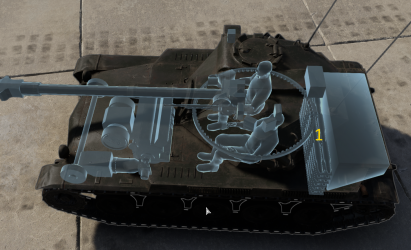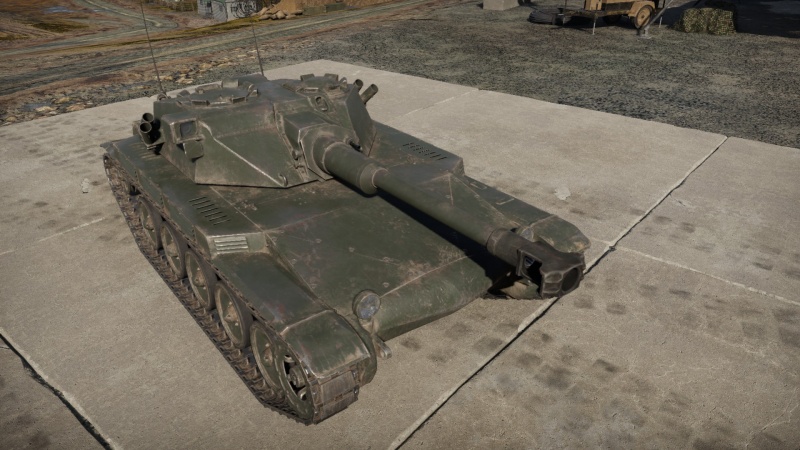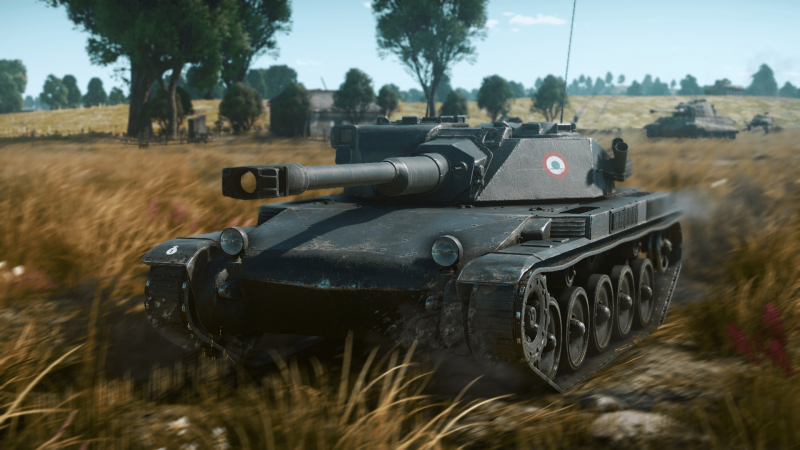ELC bis
Contents
Description
The AMX Engin Léger de Combat (ELC) bis is a prototype light tank built by the Atelier de Construction d'Issy-les-Moulineaux as part of the ELC project launched by the French Ministry of Defense in 1955. The purpose of the ELC project was to develop a lightly armoured, heavily armed combat vehicle that could be transported and deployed swiftly through airlift. The ELC concept was to mount strong anti-tank guns on a small but fully armoured tankette, resulting in a mobile, concealed light tank destroyer capable of hitting and destroying all types of enemy vehicles at a range of 1.5 kilometres. In the mid-1950s, two prototypes were designed on the Hotchkiss tankette hull, primarily differing in their primary armament; nevertheless, the running gear, engine, and mechanical components were essentially the same for both prototypes. However, towards the end of development in 1961, the ELC program was deemed unpromising, and work on the project was abandoned in favour of developing the AMX-13 light tank family. The AMX ELC bis is now on display as an exhibit at the Museum of Armored Vehicles in Saumur.
Introduced in Update "Wind of Change", the AMX ELC bis is a lightweight and mobile tank destroyer. The AMX ELC bis excels at ambush and flanking manoeuvres, thus the gameplay is centred on these characteristics. Heavy machine guns, which are prevalent on the battlefield, can readily penetrate weak spots on the front turret and instantly knock out the crew. Furthermore, the reload speed is average, making engaging several enemies highly undesirable. It is recommended to take your time selecting targets and patiently waiting for the ideal opportunity to strike. If an engagement turns dangerous, retreat as quickly as possible since the slow reverse speed can be fatal; however, this can be minimized by utilizing smoke grenades at the appropriate time.
General info
Survivability and armour
The ELC bis' armour is only sufficient to protect against small arms fire, and the 2-man crew means there is little chance of survival if shot at. In particular, while the front hull armour and parts of the front turret armour are sufficient to protect against .50 cals, there are weak spots on the front turret with an effective thickness as low as 13 mm, notably around the driver, making any encounter with vehicles equipped with .50 cals potentially deadly, even at up to 1500 m. The ELC can survive low shots however, as both the engine and transmission sit in the front of tank, and thus can absorb most of the damage if directly hit.
Armour type:
| Armour | Front (Slope angle) | Sides | Rear | Roof |
|---|---|---|---|---|
| Hull | 40* mm (75°-79°) Upper glacis 40* mm (12°-61°) Lower glacis |
15+4** mm Top 15 mm Bottom |
15 mm (21°) Upper rear 15 mm (46°) Lower Rear |
8 mm |
| Turret | 30 mm (50°) Turret front 8 mm (10°) Left turret cheek 8mm (28°) Right turret cheek 15 mm (25°) + 8mm (26°) Gun mantlet |
8 mm (12°) | 8 mm (1°) Turret rear 8 mm (62°-74°) Upper turret rear |
8 mm |
| Cupola | 8 mm | 8 mm | 8 mm | 8 mm |
Notes:
* Variable thickness cast homogeneous armour
** Structural steel
Mobility
The ELC bis has a formidable top speed of 87 km/h (AB) and 80 km/h (RB/SB). However, it suffers from poor acceleration and speed retention through turns, which is particularly noticeable in RB/SB, where the ELC will in practice only reach 60 km/h at most even when fully upgraded. Thus, its mobility on the battlefield is comparable to the American M50 and M56, which both stand at the same BR. The reverse speed is only of -10 km/h, too slow to escape dangerous encounters, which is something players must keep in mind when engaging enemies. In contrast, the ELC bis has a particularly good power-to-weight ratio, even when compared to other light vehicles at the same BR.
| Game Mode | Max Speed (km/h) | Weight (tons) | Engine power (horsepower) | Power-to-weight ratio (hp/ton) | |||
|---|---|---|---|---|---|---|---|
| Forward | Reverse | Stock | Upgraded | Stock | Upgraded | ||
| Arcade | 87 | 38 | 8.9 | 256 | 343 | 28.76 | 38.54 |
| Realistic | 81 | 35 | 159 | 180 | 17.87 | 20.22 | |
Modifications and economy
Armaments
Main armament
The 90 mm D915 cannon is unsuited for long range due to the poor ballistics of the HEATFS, and fails to make up for it in close quarters due to the average reload time. In addition, stabilizing the gun after stopping takes a few seconds, making snapshots impossible.
| 90 mm D915 | Turret rotation speed (°/s) | Reloading rate (seconds) | |||||||||||
|---|---|---|---|---|---|---|---|---|---|---|---|---|---|
| Mode | Capacity | Vertical | Horizontal | Stabilizer | Stock | Upgraded | Full | Expert | Aced | Stock | Full | Expert | Aced |
| Arcade | 36 | -8°/+13° | ±20° | N/A | 26.4 | 36.5 | 44.4 | 49.1 | 52.2 | 8.71 | 7.70 | 7.10 | 6.70 |
| Realistic | 17.9 | 21.0 | 25.5 | 28.2 | 30.0 | ||||||||
Ammunition
| Penetration statistics | |||||||
|---|---|---|---|---|---|---|---|
| Ammunition | Type of warhead |
Penetration @ 0° Angle of Attack (mm) | |||||
| 10 m | 100 m | 500 m | 1,000 m | 1,500 m | 2,000 m | ||
| OCC 60-62 | HEATFS | 350 | 350 | 350 | 350 | 350 | 350 |
| OE 90 F1 | HE | 13 | 13 | 13 | 13 | 13 | 13 |
| Shell details | ||||||||||||
|---|---|---|---|---|---|---|---|---|---|---|---|---|
| Ammunition | Type of warhead |
Velocity (m/s) |
Projectile mass (kg) |
Fuse delay (m) |
Fuse sensitivity (mm) |
Explosive mass (TNT equivalent) (g) |
Ricochet | |||||
| 0% | 50% | 100% | ||||||||||
| OCC 60-62 | HEATFS | 800 | 3.65 | 0.05 | 0.1 | 877.7 | 65° | 72° | 77° | |||
| OE 90 F1 | HE | 640 | 5.27 | 0.2 | 0.1 | 945 | 79° | 80° | 81° | |||
| Smoke shell characteristics | ||||||
|---|---|---|---|---|---|---|
| Ammunition | Velocity (m/s) |
Projectile mass (kg) |
Screen radius (m) |
Screen deploy time (s) |
Screen hold time (s) |
Explosive mass (TNT equivalent) (g) |
| OFUM PH90-F2 | 640 | 5.4 | 9 | 5 | 20 | 50 |
Ammo racks

| Full ammo |
1st rack empty |
2st rack empty |
Visual discrepancy |
|---|---|---|---|
| 53 | 35 (+18) | 1 (+52) | No |
Notes:
- Shells are modeled individually and disappear after having been shot or loaded.
- The ELC bis has two ammo racks, the first located in the turret behind the gunner and driver and the second located at the rear of the tank, just before the fuel tank.
Machine guns
The machine gun can only clear light obstacles, its primary use is to clear fences or other elements that would otherwise make your HEATFS shells detonate before reaching the target. Vehicles with exposed crew aren't particularly common at the ELC's battle rating, the main vehicles the ELC encounters where the machine gun can prove useful against are the American M42 and M56.
| 7.5 mm AAT-52 | ||||
|---|---|---|---|---|
| Mount | Capacity (Belt) | Fire rate | Vertical | Horizontal |
| Coaxial | 4,800 (200) | 900 | - | - |
Usage in battles
Despite looking like one, it is important to remember that the ELC bis is not a light tank. It is strictly a tank destroyer, a fact highlighted by the absence of the scouting ability. The ELC bis is mobile but is generally slower than other light vehicles of the same BR, thus it is not really able to capture points early-on. The ELC excels in camouflage and in taking spots normally unattainable, and the gameplay generally revolves around this. The ELC bis is best unseen: .50 cal MGs, which are common at the BR, can penetrate weak spots on the front turret and immediately knock out the crew. In addition, the reload speed being simply average makes engaging multiple enemies not desirable. But in RB and SB, that is where the ELC's top-notch camouflaging ability comes into play, as the ELC bis can take the time to choose its targets carefully and patiently wait for the right time to strike. The slow reverse speed can be deadly if an engagement turns out dangerous, but this can be alleviated with a promptly-timed usage of the smoke grenades.
HEATFS being the ELC's only available shell, large tanks can be hard to deal with, but in particular, extra care is required against the Centurion Mk.5 AVRE, as its ERA armour is extremely efficient against HEATFS rounds.
Pros and cons
Pros:
- Incredibly small profile, can hide in places that are simply impossible for other vehicles
- Good mobility
- Formidable top speed of 80 km/h
- HEATFS rounds with 320 mm of penetration, making enemy armour not a concern
Cons:
- Only 2 crew members, both sitting in a small turret: hits on the turret are nearly always fatal
- Front turret weak spots make the ELC vulnerable to .50 cal MGs even from the front
- Weak top armour: 20 mm cannons and 50 cal MGs found on aircraft rip right through and knock out the crew as well
- Rarely reaches its top speed in RB and SB
- Reverse speed is underwhelming for a light tank
- Cannot fully traverse the turret 360 degrees
- Low muzzle velocity on the HEATFS shells: not suited for engaging moving targets at long range
- Low gun elevation
- Tank rocks back and forth when coming to a stop, which makes aiming very hard
History
Pre-Development
France first became interested in developing a lightly armoured combat vehicle capable of being airlifted in November 1946. While this project fell through, another program was launched 10 years later in 1954, the Engin Léger de Combat (ELC) "light combat vehicle" project. The ELC program was spearheaded by two main competitors, Ateliers de construction d'Issy-les-Moulineaux (AMX) and Brunon-Vallette (EVEN).[1][2] The idea was to create a light combat vehicle mounting an anti-tank armament on a slightly less completely armored tank chassis and to create a mobile light tank destroyer. One that would be barely visible, capable of engaging and defeating all types of enemy tanks up to a distance of approximately 1000 meters, which was then increased to 1500 meters.[3]
In March 1954, AMX engineers based their first design of the ELC, designated Chenillette 4-120SR, off of the Hotchkiss CC-2 transporter. While AMX envisioned a two-seat combat vehicle armed with four 120 mm recoilless rifles, this did not make it off paper (not to be confused with EVEN's similar designs of the ELC Even 120).[4] 4 months later, in July 1954, another project was proposed, the Chenillette 6-105SR, armed with six 105 mm recoilless rifles. Again, this version did not make it off paper.[2]
Development
The AMX ELC bis was first conceived on April 27th, 1954. Originally called the 'Chenillette biplace avec casemate tournante de 90' (2-seat wedge with a 90 mm gun mounted in a casemate turret), AMX designers placed both crew members in the turret, with the engine in the bow. This allowed for a very compact vehicle layout. However, this meant that the turret could only rotate if the vehicle was not in motion, as the driver would not have visibility and access to the controls. In December 1954, a redesign placed the driver in the wheelhouse, moving the turret forward and the engine and transmission to the back. The first prototype entered testing in 1955, with a 90 mm D914 cannon inserted in a two-man TC.901 turret developed by FAHM (Forges et Aciéries de la Marine et d'Homécourt, a.k.a. Saint-Chamond).[2]
The D914 gun was capable of firing 90mm Empennée HEAT rounds, but was found to be inadequate, and thus an improved D915 cannon, capable of firing what were designated 'G shells' was created, prompting the development of a new turret. In total, 4 turrets were created, TC.901 through TC.904. TC.901 and TC.902 both were fit with the D914 gun and ANVRC 7 radio while the TC.903 and TC.904 were created and fit with the D915 gun and a different ANGRC 4 radio. In addition, the TC.902 and TC.904 were both equipped with rangefinders.[3] In 1957, after two years of testing, a new chassis was designed and the second and final prototype of the AMX ELC bis using the TC.904 turret and D915 gun was created. Differing from the first prototype, it included, smoke grenade launchers, redesigned observation devices, a rangefinder and an increase in road wheels to five. The gun mantlet, engine compartment roof and upper front plate were all changed, including the equipment mounted on them.[1][4] The final AMX ELC bis prototype was equipped with a 4-cylinder SOFAM Type 4 GSr engine with a power of 180 hp, resulting in a specific power of 20 hp/t and a top speed of 80 km/h. The tank was estimated to weigh a total of 8920 kg with crew and ammunition.[5]
Development concluded in 1958,[3] and while testing continued, the ELC program was eventually closed in 1961.[5] The project was discontinued in favour of improving the AMX-13 light tank.[4]
Media
- Skins
See also
Links to the articles on the War Thunder Wiki that you think will be useful for the reader, for example:
- reference to the series of the vehicles;
- links to approximate analogues of other nations and research trees.
External links
References
- Citations
- Bibliography
- "French Christmas Tree." Warspot, 2015, https://warspot.ru/4780-frantsuzskaya-yolka
- Centre des hautes études de l'Armement. Les Ingénieurs Militaires et l'Émergence d'une Nouvelle Industrie Française de l'Armement: 1945-1960. CHARME, 2000
- "AMX ELC 90." Tank Archives, 2016, https://www.tankarchives.ca/2016/02/amx-elc-90.html
- AMX, "AMX ELC: General history, armament, casemate turret, mobility, turret modifications", 1958, https://archive.org/details/al-9n-zevau-0-rurc-u-h-9fzex-ufm-0-sqxgx-bg-x-4-spka-n-4-vnbc-by-74-ct-4-rwwivop
- AMX, "AMX ELC bis performance, mass, gabarites", 1961, https://archive.org/details/2022-09-18-214717589
| Ateliers de construction d'Issy-les-Moulineaux (AMX) | |
|---|---|
| Light tanks | |
| AMX-13 | AMX-13-M24 · AMX-13 (FL11) · AMX-13 · AMX-13 (SS.11) · AMX-13-90 · AMX-13 (HOT) |
| Armoured cars | AMX-10RC |
| Medium tanks | AMX M4 · AMX-50 (TOA100) |
| MBTs | |
| AMX-30 | AMX-30 · AMX-30 ACRA · AMX-30 (1972) · AMX-30B2 · AMX-30B2 BRENUS · AMX-30 Super |
| AMX-32/40 | AMX-32 (105) · AMX-32 · AMX-40 |
| Heavy tanks | AMX-50 Surbaissé · AMX-50 Surblindé |
| Tank destroyers | ELC bis · AMX-50 Foch |
| SPAAGs | AMX-13 DCA 40 · AMX-30 S DCA |
| Export | AMX-13 |
| France tank destroyers | |
|---|---|
| Lorraine 40t derivatives | CA Lorraine · Lorraine 155 Mle.50 |
| ATGM | MEPHISTO · AMX-10M |
| Other | AMR.35 ZT3 · Lorraine 37L · SAu 40 · ARL-44 · ELC bis · AMX-50 Foch · AuF1 |
| USA | ▄M10 GMC · ▄M36B2 |






